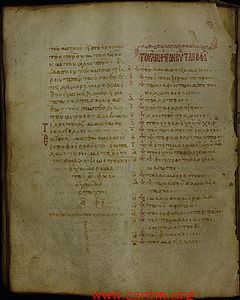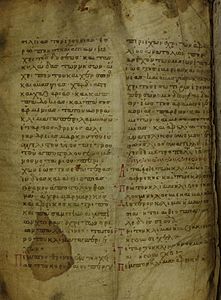|
Minuscule 543
Minuscule 543 (in the Gregory-Aland numbering of New Testament manuscripts), ε 257 (in von Soden's numbering of New Testament manuscripts) and labelled 556 by biblical scholar and textual critic F. H. A. Scrivener,[1][2]: 255 is a Greek minuscule manuscript of the New Testament, written on parchment. Using the study of comparative handwriting styles (palaeography) it has been assigned to the 12th century.[3] The manuscript contains the text of the four Gospels, with some gaps and some unusual grammar forms and numerous errors. The manuscript is housed at the University of Michigan.[3] DescriptionContentsThe manuscript is a codex (precursor to the modern book), containing the text of the four Gospels on 184 thick parchment leaves (size 28 cm by 23 cm), with several gaps (Matthew 12:11-13:10; Mark 8:4-28; Luke 15:20-16:9; John 2:22-4:6; 4:52-5:43; 11:21-47). One leaf was misplaced during its binding. The parchment is coarse and yellowed by age.[4]: 28 The text of the codex was written two columns per page, 27-30 lines per page,[3] 17 letters per line,[4]: 28 in a minute hand using brown ink.[4]: 30 The same scribe copied all four Gospels.[4]: 28 Breathings (utilised to designate vowel emphasis) and accents (used to indicate voiced pitch changes) are employed in regular form, but in some sort of system. Iota subscript (a small Greek letter ι (iota) written underneath vowels in certain words to indicate a change of sound) is not used, though iota adscriptum (where the ι is written as part of the main text with the same function as the iota subscript) occurs very often, especially in the Gospel of Mark.[5]: XIX The titles to the Gospels of Matthew and Mark run: Ευαγγέλιον εκ του κατά Ματθαίου (Μάρκου) (The Gospel of that according to Matthew (Mark)).[n 1] The titles to Luke and John are the usual: Ευαγγέλιον κατά Λουκάν (Ιωάννην) (The Gospel according to Luke (John)).[2]: 255 The lists of the chapters (known as κεφαλαια / kephalaia) are placed before each Gospel; the numbers of the κεφαλαια are given at the left margin, with their titles (known as τιτλοι / titloi) in red at the top of the pages. There is a division according to the Ammonian Sections, with references to the Eusebian Canons (an early system of dividing the four Gospels into different sections). It contains lectionary markings (to indicate what verse was to be read on a specific day in the churches yearly calendar), Synaxarion (a list of saint's days), Menologion (a list of readings to be read each calendar month), subscriptions, lists of how many phrases (known as ρηματα / rhemata) are used in each gospel, and how many lines (known as στιχοι / stichoi) are written in each gospel.[2]: 255 [6] The list of κεφαλαια to Matthew is missing, and the Gospel of Matthew begins on the first page of the codex.[4]: 28 It has additional non-biblical material: The Limits of the Five Patriarchates (as in codices 69 and 211), of which one page is lost.[4]: 27 [7] Nomina sacra and OT quotationsThe nomina sacra are contracted in the usual way, but there are a number of words which the scribe failed to abbreviate. In some of the cases where nomina sacra are uncontracted, they have the heavy bar signifying contraction. υιος (son) is contracted only once (John 4:47). On the other hand, it gives the unusual abbreviations for the other nomina sacra. Some unusual ones are σταυρωσον (crucify), which is written as στωσον; σταυρωθη (to be crucified) — στρωθη; and παρθένος (virgin) is contracted to παρθνος.[4]: 28–29 Quotations from the Old Testament are indicated in the left margin by a rubricated letter or sign.[4]: 30 ErrorsAlmost all the necessary corrections of misspellings have been made. Sometimes a stroke of the pen indicates an error, perhaps to be corrected later.[4]: 30 Some corrections seem to be written by the first hand (e.g. Matthew 4:10; 5:19) others plainly by a second hand (Matthew 6; Luke 3; 10:35).[5] The apostrophe is used even when not required, especially in εξ', and ουκ'.[4]: 30 According tο Scrivener, movable nu occurs 416 times especially with words ειπεν, εστιν. In Matthew 12:7; Luke 8:10; John 5:46; 7:7; 8:27 there is a hiatus for lack of it.[5]: XIX The error of iotacism occurs 358 times: ει for ι (16 occurrences), ι for ει (35), ο for ω (40), ω for ο (33), αι for ε (13), ε for αι (31), ει for η (23), η for ει (19), η for ι (11), ι for η (7), ε for η (11), η for ε (2), οι for ι (3), ω for ου (20), η for υ (3), υ for η (5), υ for οι (1), υ for ει (1), η for οι (1), οι for η (1), ι for υ (1), οι for ει (2).[5] There are many errors by homoeoteleuton, where words/phrases are skipped over when the words/phrase following ends with the same letters (Mark 2:18; 4:24; 12:26; 14:70; 15:14; Luke 12:22.47; 13:28.29; John 4:14).[5]: XIX There are some unusual forms like: ανεπεσαν, ειπαν, εθεωρων, εμελλεν, εμπροσθε, εσπλαγχνισθη, ιδαμεν, ιδεν, σαρκαν, συνετιθεντο.[5]: XIX TextThe Greek text of the codex has been considered a representative of the Caesarean text-type. It belongs to the textual family ƒ13, known also as the Ferrar Group/Family.[8] The handwriting and the menology show the manuscript is a close member of the group.[4]: 26 According to biblical scholars and textual critics Kurt and Barbara Aland, it agrees with the Byzantine standard text 151 times, and 72 times with the Byzantine when it has the same reading as the original text. It agrees 31 times with the original text against the Byzantine. It has 57 independent or distinctive readings. It is currently placed in Category III.[9] According to the Claremont Profile Method, it represents the textual ƒ13 in Luke 1, Luke 10, and Luke 20, as a core member.[8] The Pericope Adulterae follows Luke 21:38, as in other manuscripts of the Ferrar Family.[2]: 255
The words after the square bracket are the readings of the codex (before the square bracket are readings of the Textus Receptus).
History Concerning the history of the manuscript, nothing is known until the year 1864, when it was in the possession of a dealer at Janina in Epeiros. It was then purchased from him by a representative of Baroness Burdett-Coutts (1814–1906), a philanthropist,[10] together with other Greek manuscripts (among them codices 532-546).[6] They were transported to England in 1870–1871.[11] The manuscript was presented by Burdett-Coutts to Sir Roger Cholmely's School, and was housed at the Highgate (Burdett-Coutts III. 5), in London.[5]: XVI–XVII In 1922 it was acquired for the University of Michigan[4]: 26 [12] It is currently housed at the University of Michigan (Ms. 15) in Ann Arbor.[3] J. Rendel Harris pointed out that the menology of the Ferrar group contains saints which appear to be peculiar to Calabria or Sicily.[13] Abbe Martin had previously stated that certain palaeographical traits to be observed in these manuscripts were characteristic of Calabrian scriptoria.[4]: 26 Scrivener observed a close textual affinity to the Ferrar group and announced in 1883 in the third edition of "Plain Introduction" as pertaining to the same class.[2]: 236 Scrivener collated its text and it was edited posthumously in 1893.[5]: 1–59 This collation was not wholly accurate and Jacob Geerlings, from the University of Utah, gave a new and more accurate collation in 1932.[4]: vii Gallery
See alsoNotes
References
Further reading
For more bibliography see: Family 13 External links
|
||||||||||||||||||||||



